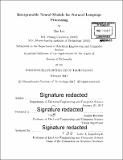| dc.contributor.advisor | Regina Barzilay. | en_US |
| dc.contributor.author | Lei, Tao, Ph. D. Massachusetts Institute of Technology | en_US |
| dc.contributor.other | Massachusetts Institute of Technology. Department of Electrical Engineering and Computer Science. | en_US |
| dc.date.accessioned | 2017-05-11T19:59:27Z | |
| dc.date.available | 2017-05-11T19:59:27Z | |
| dc.date.copyright | 2017 | en_US |
| dc.date.issued | 2017 | en_US |
| dc.identifier.uri | http://hdl.handle.net/1721.1/108990 | |
| dc.description | Thesis: Ph. D., Massachusetts Institute of Technology, Department of Electrical Engineering and Computer Science, 2017. | en_US |
| dc.description | Cataloged from PDF version of thesis. | en_US |
| dc.description | Includes bibliographical references (pages 109-119). | en_US |
| dc.description.abstract | The success of neural network models often comes at a cost of interpretability. This thesis addresses the problem by providing justifications behind the model's structure and predictions. In the first part of this thesis, we present a class of sequence operations for text processing. The proposed component generalizes from convolution operations and gated aggregations. As justifications, we relate this component to string kernels, i.e. functions measuring the similarity between sequences, and demonstrate how it encodes the efficient kernel computing algorithm into its structure. The proposed model achieves state-of-the-art or competitive results compared to alternative architectures (such as LSTMs and CNNs) across several NLP applications. In the second part, we learn rationales behind the model's prediction by extracting input pieces as supporting evidence. Rationales are tailored to be short and coherent, yet sufficient for making the same prediction. Our approach combines two modular components, generator and encoder, which are trained to operate well together. The generator specifies a distribution over text fragments as candidate rationales and these are passed through the encoder for prediction. Rationales are never given during training. Instead, the model is regularized by the desiderata for rationales. We demonstrate the effectiveness of this learning framework in applications such multi-aspect sentiment analysis. Our method achieves a performance over 90% evaluated against manual annotated rationales. | en_US |
| dc.description.statementofresponsibility | by Tao Lei. | en_US |
| dc.format.extent | 119 pages | en_US |
| dc.language.iso | eng | en_US |
| dc.publisher | Massachusetts Institute of Technology | en_US |
| dc.rights | MIT theses are protected by copyright. They may be viewed, downloaded, or printed from this source but further reproduction or distribution in any format is prohibited without written permission. | en_US |
| dc.rights.uri | http://dspace.mit.edu/handle/1721.1/7582 | en_US |
| dc.subject | Electrical Engineering and Computer Science. | en_US |
| dc.title | Interpretable neural models for natural language processing | en_US |
| dc.type | Thesis | en_US |
| dc.description.degree | Ph. D. | en_US |
| dc.contributor.department | Massachusetts Institute of Technology. Department of Electrical Engineering and Computer Science | |
| dc.identifier.oclc | 986521795 | en_US |
